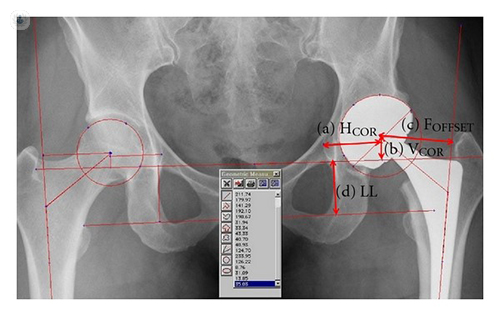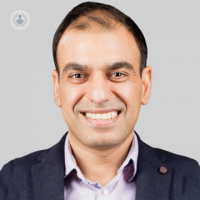Optimising total hip replacement
Escrito por:Total hip replacement (THR) has revolutionised orthopaedic care, offering renewed freedom of movement to countless individuals. But what makes for the best THR? In his latest online article, Mr Farid Ud Din gives us his insights.

Total hip Replacement is the most successful orthopaedic intervention of its generation and known as the operation of the century. Sir John Charnley (1911-1982), who pioneered the modern hip arthroplasty, performed the first THR in 1962 at Wrightington hospital. Since then, there has been multiple modifications in the technique, manufacturing and the processing of the procedure and the implants respectively. The modern total hip replacement lasts for 15-25 years in the majority of patients.
In order to understand how the hip replacement functions it’s important to know about the components of the hip replacement and how the correct positioning of those components can result in the best outcome.
Total Hip replacement has mainly four components, acetabulum, liner, head, and the stem as seen in the photo below:

It is absolutely essential to fix these components exactly in the position that is specific to the patient. There are three main principles of a successful hip replacement, firstly, the leg length restoration, cartilage wear will lead to slight shortening of the affected leg and while doing the hip replacement its crucial to restore leg length back to normal. Mr Ud-Din not only uses clinical assessment but also uses special templating software to make sure he restores the leg length to normal.
The second principle is to implant the acetabulum in the normal centre of rotation. Implanting acetabulum higher or lower than normal centre of rotation can lead to change in the biomechanism of hip and it will not feel like a normal hip and can cause lateral sided hip pain.
The third principle is to maintain normal off set of the hip. Increasing the offset can cause excessive tension on the lateral soft tissue like tensor fascia lata and can cause pain and tenderness on the lateral side, on the other hand if you decrease the offset, the muscle can become lax and cause gait disturbances.

There are many ways to fix those components, i.e. uncemented, cemented or hybrid. Mr Ud-Din uses all three types of hip replacements depending upon the patient bone stock.
Most of the hip replacement he chooses are uncemented and they are ODAP 15 A* rated implant.
Most of the uncemented acetabular and femoral components are made of titanium alloy and that provides the best compatibility with the tissues and almost the same elasticity as the bone. The liner is made of HXLPE, its extremely durable and has a negligible wear rate.
Mr Ud-Din, uses ceramic or a metal femoral head depending upon the age, head size and cost. Ceramic provides one of the best articular surfaces because of its properties and minimal wear rate.
Mr Farid Ud-Din is an esteemed consultant trauma and orthopaedic surgeon. You can schedule an appointment with Mr Ud-Din on his Top Doctors profile.


